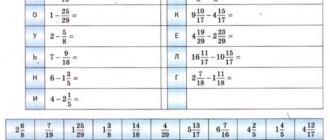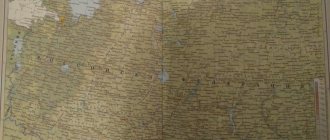Goals and objectives of using ICT
The goals of using a computer in mathematics lessons are the following: development of interdisciplinary connections between mathematics and computer science; formation of computer literacy; development of independent work of students in the classroom; implementation of an individual, person-oriented approach.
My tasks as a mathematics teacher are the following:
· Provide fundamental mathematical training for children;
· To form an information and methodological culture, a creative style of activity of students;
· Prepare students to use information technology and other information structures.
The use of ICT in mathematics lessons allows the teacher to reduce the time spent studying the material due to clarity and speed of work, test students' knowledge interactively, which increases the effectiveness of learning, helps to realize the full potential of the individual - cognitive, moral, creative, communicative and aesthetic , promotes the development of intelligence and information culture of students.
The use of ICT in the educational process implies improving the quality of education, i.e., solving one of the pressing problems for modern society.
The process of organizing schoolchildren’s education using ICT allows:
· make this process interesting, on the one hand, due to the novelty and unusualness of this form of work for students, and on the other, make it exciting and vibrant, varied in form through the use of the multimedia capabilities of modern computers;
· effectively solve the problem of visualization of learning, expand the possibilities of visualizing educational material, making it more understandable and accessible to students, freely search for educational material necessary for schoolchildren in remote databases through the use of telecommunications, which will further contribute to the formation of students' need for search actions;
· individualize the learning process through the presence of multi-level tasks, through immersion and assimilation of educational material at an individual pace, independently, using convenient ways of perceiving information, which evokes positive emotions in students and forms positive learning motives;
· to liberate students when answering questions, because the computer allows you to record results (including without assigning a grade), and responds correctly to errors; independently analyze and correct mistakes made, adjust your activities thanks to the presence of feedback, as a result of which self-control skills are improved;
· carry out independent educational and research activities (modelling, project method, development of presentations, publications, etc.), thereby developing creative activity among schoolchildren.
The modern information society confronts all types of educational institutions and, above all, schools with the task of preparing graduates capable of:
· adapt flexibly to changing life situations,
· think critically on your own;
· competently work with information;
· be sociable and contactable in various social groups; independently work on the development of one’s own morality, intelligence, and cultural level.
The use of information technologies in education is based on data from human physiology: 1/4 of the material heard, 1/3 of what is seen, 1/2 of what is seen and heard, 3/4 of the material remains in a person’s memory if the student actively participates in the process.
In order to intensify learning, along with the classical forms of teaching previously used in teaching mathematics at school and in the independent work of students, software for academic disciplines is increasingly being used: textbook programs, training programs, dictionaries, reference books, encyclopedias, video tutorials, libraries of electronic visual aids , themed computer games.
The capabilities of a computer, when using additional technologies adapted to it: software products, the Internet, network and demonstration equipment, constitute the material base of information and communication technologies.
Prospects for using ICT in mathematics lessons
A lot can be said about the advantages of using digital technologies in mathematics: it makes it possible to use new options for traditional forms and means of education, it is presented in a playful way and arouses great interest among students, it provides clarity, allows you to simulate a variety of situations, etc. However, the use of digital technologies by a teacher should be much more diverse, since the teacher broadcasts his teaching experience not only to students. The use of digital technologies in work is not just a requirement of the time, but a necessity for the development and self-realization of a teacher in his professional activities [1].
To determine the goals and objectives of digital technologies in the work of a mathematics teacher, it is necessary to know the definition of digital technologies and how these technologies differ from the concept of EER (electronic educational resources).
Digital technologies are a complex of educational and methodological materials, technical and instrumental means of computer technology in the educational process for improving the activities of teachers, as well as for the educational process (development, diagnosis, correction) of children.
A critical factor in continuing to develop teachers' digital skills is their regular access to functioning and associated ICT equipment [2]. The way digital technologies are used in mathematics lessons depends on teachers' knowledge of their subject and how ICT resources can be used and linked to it. By providing access to updated and additional learning resources, digital technologies can enable teachers to learn independently in their subject area [3].
Effective use of digital technologies in mathematics classrooms enhances teacher preparation and professional development needs. Thus, digital technologies can be important tools to help meet increased needs by helping to provide access to more and better educational content. In addition, they are able to provide models and simulations of effective methods of teaching mathematics and provide student support, distance learning, and in real time or asynchronously [4].
Successful models of professional development can be divided into three stages:
- pre-service, which focuses on initial preparation;
- subject mastery, management skills and use of various teaching tools; including structured in-person and distance learning opportunities that build on pre-service learning and are directly related to teacher needs;
- ongoing formal and informal pedagogical and technical support provided by ICT for teachers focused on everyday needs and problems.
Effective professional development for teachers should be as close to the classroom environment as possible. 'Hands-on' instruction in the use of digital technologies is required where it is considered a vital component of the mathematics teaching process. In addition, professional development activities should model effective practices and behaviors and encourage and support collaboration among teachers. Continuous professional development at the school level using available ICT tools is seen as a key success factor, especially when it comes to resources and skills directly related to teachers' daily needs and practices [5].
Because the introduction of digital technologies to support mathematics is often part of a larger process of change or reform, it is essential that the successful use of ICT is encouraged and shared.
Digital technologies are used in education, and in mathematics in particular, in two main ways: to support existing "traditional" pedagogical practices (teacher-centered, lecture-based, tutorial-based teaching), and to create more learner-centered, "constructivist" teaching models. . Research from OECD countries suggests that both are useful, but that ICT is most effective when it supports learner-centred teacher training.
However, research on the use of ICT in LDCs suggests that, despite the rhetoric that ICT can develop new types of teaching and learning styles, for the most part it is used to support traditional teaching methods.
Conclusion
This work was aimed at showing the potential that digital technologies hold, as well as demonstrating the practical application of this potential using the example of a mathematics teacher. To achieve this goal, a number of tasks were solved: relevant material was collected, analysis was carried out, and options for using ICT in the classroom were developed, as well as for developing the professional qualities of a teacher.
Bibliography
- Azarov, Yu.P. Family pedagogy. Raising a child in love, freedom and creativity / Yu.P. Azarov. - M.: Eksmo, 2020. - 496 p.
- Bordovskaya, N.V. Psychology and pedagogy: Textbook for universities. Third generation standard / N.V. Bordovskaya, S.I. Rozum.. - St. Petersburg: Peter, 2013. - 624 p.
- Borozdina, G.V. Psychology and pedagogy: Textbook for bachelors / G.V. Borozdina. — Lyubertsy: Yurayt, 2020. — 477 p.
- Gurevich, P.S. Psychology and pedagogy: Textbook for bachelors / P.S. Gurevich. - Lyubertsy: Yurayt, 2020. - 479 p.
- Dzhurinsky, A.N. Comparative pedagogy: Textbook for undergraduate and graduate studies / A.N. Dzhurinsky. - Lyubertsy: Yurayt, 2016. - 440 p.
Use of ICT at stages of the learning process
Information technologies, in my opinion, can be used at various stages of a mathematics lesson:
- independent learning with the absence or denial of teacher activity;
— independent learning with the help of a teacher-consultant;
— partial replacement (fragmentary, selective use of additional material);
— use of training (training) programs;
— use of diagnostic and monitoring materials;
- completing independent and creative homework assignments;
- use of a computer for calculations, drawing graphs;
— use of programs that simulate experiments and laboratory work;
- use of gaming and entertaining programs;
— use of information and reference programs.
Since visual-figurative components of thinking play an extremely important role in human life, their use in studying material using ICT increases the effectiveness of learning:
— graphics and animation help students understand complex logical mathematical constructions;
— the opportunities provided to students to manipulate (explore) various objects on the display screen, change the speed of their movement, size, color, etc. allow children to assimilate educational material with the fullest use of the senses and communication connections of the brain.
The computer can be used at all stages of the learning process: when explaining new material, consolidating, repeating, monitoring, while for the student it performs various functions: teacher, working tool, learning object, collaborating team.
The computer allows you to enhance the motivation of learning through an active dialogue between the student and the computer, the variety and colorfulness of information (text + sound + video + color), by focusing learning on success (allows you to complete the solution of any problem, relying on the necessary help), using the gaming background of communication between a person and the machine and, importantly, the restraint, calmness and “friendliness” of the machine towards the student.
In addition to the above, it is of great importance that in the process of work between a student and a teacher using computer technology, the student, firstly, gradually enters the real world of adults, the production activity of a modern person.
Secondly, the widespread introduction of ICT into the life of a modern person puts teachers in a dilemma: either you keep up with the times, teach children in a modern way, using modern teaching technologies, or you fall behind and leave the profession.
When choosing conditions for using ICT, I take into account:
— availability of programs relevant to the topic being studied;
— number of computerized workplaces;
— students’ readiness to work using a computer;
— the student’s ability to use computer technology outside of class.
Using information technology in mathematics lessons (from work experience)
In the 21st century, the information revolution has led to the widespread use of new information technologies and the Internet in education. Information technologies open access to non-traditional sources of information, increase the efficiency of independent work, provide an opportunity for creativity, and allow the implementation of fundamentally new forms and methods of teaching. The computer, together with information tools in the educational process, opens up new opportunities in the work of the teacher and in the educational activities of the student. Information technologies (IT) are becoming the main tools in human professional practice.
Information technology refers to the processes of accumulation, processing, presentation and use of information using electronic means.
Today, the introduction of information technology into the educational process is an integral part of learning. It is generally accepted that the use of computer technologies in education is inevitable, since the effectiveness of learning and the quality of emerging knowledge and skills significantly increases, especially now within the framework of the Federal State Educational Standard when implementing a competency-based approach to learning, which strengthens the applied, practical nature of subject-based learning.
Now on the Internet you can find all kinds of software products that can be used by teachers when conducting classes using new information technologies. Such classes make it possible to increase the motivation of students in studying subjects of the natural and mathematical cycle, to intensify their cognitive activity, and to form a general worldview at the modern scientific level.
Increasing the effectiveness of education is impossible without creating new forms of education. In this regard, today much attention is paid to the project activities of students. Independent work of students with a computer, work on the information object itself, the use of materials from various CDs, Internet resources, some programs and utilities, will allow them to create small works of their own in a short time.
It is generally accepted that mathematics is a labor-intensive academic discipline that requires students to carry out constant, painstaking and significant independent work, which is very specific and varied. In addition, mathematics is the basis for the study of general professional disciplines and interdisciplinary courses. Therefore, one of the main tasks of a mathematics teacher is the formation and development of skills in studying mathematics, elements of a culture of learning and thinking.
One of the reasons for the use of new information technologies in the educational process is that teachers are constantly forced to solve the dilemma of how to “pack” the growing volume of studied material into a small number of hours, which tends to decrease. On the other hand, there is a need for carefully selected educational materials and manuals that can be used during educational and practical classes.
The increase in mental load in mathematics classes makes us think about how to maintain students’ interest in the subject being studied and their activity throughout the entire lesson. To maintain interest in the subject and make the educational process high-quality, we actively use information technology in the classroom.
The use of computer software in mathematics lessons allows the teacher not only to diversify traditional forms of teaching, but also to solve a variety of problems: significantly increase the visibility of learning, ensure its differentiation, facilitate control of knowledge, increase interest in the subject, and the cognitive activity of students.
In my work I use information technologies in the following areas:
- showing slides (using presentations);
- work in the mathematical environment MathCad;
- implementation of mathematical models in Microsoft Excel;
- use of electronic textbooks for independent work of students;
- students' use of network resources to prepare messages on topics;
- using an interactive whiteboard.
Multimedia presentations have become firmly established in the educational process. Almost every teacher who has practical skills in information technology uses them in their daily work. It is most effective to use presentations and an interactive whiteboard when conducting lectures, practical classes, independent work, and testing.
To conduct lessons, I create educational presentations in Microsoft Power Point on various topics (“Vectors”, “Linear Algebra”, “Graphical method for solving systems of linear inequalities with two variables”, “Mathematical modeling”, “Reading the properties of a function from graphs”, “Various cases of calculating areas”, “Trigonometric functions of a numerical argument”, “Graphs of trigonometric functions” and others) or I take ready-made presentations, for example, from the site www.rusedu.ru.
In preparation for the Federal Internet Exam, I teach classes using the “Internet Trainer” software test module, which can be used at different stages of the training session and in different forms. This includes home tests on selected topics, online testing in the classroom, and an explanation of any difficult aspects of the educational material. These module functionalities are convenient from the point of view of monitoring the mastery of the material, since each student receives his own version of the work.
Using a multimedia projector and demonstration screen, I present the created slides in appropriate classes. A presentation allows you to abandon all other types of visualization and focus the teacher’s attention as much as possible on the course of the lesson. As the lesson progresses, the necessary material is gradually displayed on the screen, and the main issues of this topic are discussed. If necessary, I can replace text, drawings, diagrams, or simply hide unnecessary slides. These program features allow you to maximally customize any existing presentation for a specific lesson in a specific group of students.
In mathematics classes I use the ready-made software product MathСad. This is a software tool, an environment for performing various mathematical and technical calculations on a computer, equipped with an easy-to-learn and easy-to-use graphical interface, which provides the user with tools for working with formulas, numbers, graphs and texts. In the MathСad environment, students perform practical work on calculating the values of expressions, specifying functions and finding the value of a function at a certain point, performing operations on matrices, solving systems of linear equations, and solving simple linear programming problems.
When studying mathematical modeling I use Microsoft Excel. In particular, students solve linear programming problems using the simplex method and solve transport problems using the enormous capabilities of this software product. Also, this software product is very productive to use when working on the topic “Elements of Mathematical Statistics”.
Currently, it is impossible to imagine teaching mathematics without the use of various electronic textbooks and books, which, like paper ones, contain only a presentation of the material, but in electronic form. Basically, electronic textbooks on mathematics are used by students to independently prepare for classes.
Thus, the use of electronic learning tools in the classroom ensures:
- saving time when explaining new material;
- presenting the material in a more visual, accessible form;
- impact on different systems of perception of students, thereby ensuring better assimilation of the material;
- the ability to analyze the results and give a graphical representation of what was obtained;
- a differentiated approach to teaching students with different levels of readiness to perceive the material;
- increasing the number of different tasks and exercises to develop practical skills;
- constant operational monitoring of students’ mastery of the material.
This, in general, stimulates a variety of creative activities of students, makes it possible to increase the amount of information, develops self-control skills, and increases interest in the subject.
The use of an interactive whiteboard especially facilitates the teacher’s work when studying stereometry, problems involving the construction of sections, tasks involving the use of complex formulas, tasks on constructing a graph, and much more.
Information technologies make it possible to improve the quality of independent learning. Everything that is obtained through one’s own labor has enormous educational value. Thus, the success of learning is determined by the attitude of students to learning, the desire for knowledge, the conscious and independent acquisition of knowledge, skills and abilities, and their activity.
Despite the diversity and capabilities of computer educational technologies, these are just tools that, when used competently and skillfully, become an assistant for the teacher. A modern teacher needs to learn how to skillfully use information technology, then our students will become a little more independent, more active, and most importantly, creatively thinking, and then it will not be the teacher who fills the entire space of the classroom, but his students.
Each teacher has the right to choose his own technology and methods of work, but each teacher is obliged to work for the benefit of human development.
Types of ICT implementation
Remembering the words of K. F. Gauss that “mathematics is a science for the eyes, not for the ears,” I believe that mathematics is one of those subjects in which the use of ICT can enhance all types of educational activities: learning new material, preparation and checking of homework, independent work, tests and tests, extracurricular work, creative work. Based on the use of ICT, many methodological goals can be realized more effectively.
Information technology, according to G.K. Selevko can be implemented in three versions:
· as “penetrating” (using a computer when studying individual topics, sections, to solve individual didactic problems);
· as the main one (the most significant in the pedagogical technology used);
· As a monotechnology (when all teaching and management of the educational process, including all types of diagnostics, control and monitoring, are based on the use of a computer).
Of course, the ideal option that every teacher strives for is monotechnological teaching, i.e. independent educational work of the child in an interactive learning environment, using ready-made electronic training courses. The use of information technology must be considered in the inextricable unity of all components of the educational process:
· creating lessons using IT;
· creative project work of students;
· distance learning, competitions;
· library, Internet resources;
· elective courses;




